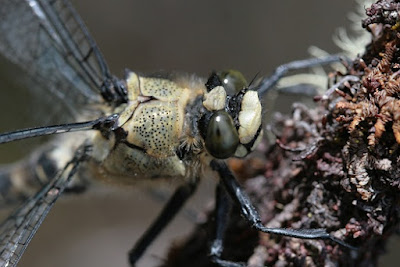In any new country, I get to see plenty of new birds, insects, plants, etc… Very rarely do they excite me as much as this dragonfly did.
 |
| Phenes raptor, male, Nov 14, 2011 |
I was out walking along one of the trails in the wet scrub habitat here when over my head came this GIGANTIC dragonfly. It landed not 15 feet from me and when I got it in my binoculars, I was able to see the widely separated eyes – the mark of only one dragonfly family: the petaltails (Petaluridae). I rushed over and quickly caught it and once in my hand, I realized that this guy made Anax junius – the big species back home – look tiny. It was too big to hold out and get the entire dragonfly in the frame with the 100mm lens…
 |
| the widely spaced eyes are unique in dragonflies |
But it wasn’t just the size that was amazing about this dragonfly, the petalurids are the most ancient of the dragonfly families, and one of the rarest. Worldwide, there are only 11 species, most of which are in Australia/New Zealand, though there are two in the US and one in Japan as well as this one in South America. Little is known about the family and their habits, though their larvae live terrestrially (in wet soil) and some burrow, which is a marked departure from the fully aquatic habits of all other odonate larvae.
 |
| Look at the appendages on the abdomen for holding the female during mating! |
That day, all counting, I saw three of these and the next day I was able to catch a female at a little boggy area in the forest here. Compared to other big dragonflies (big Aeschnids and Gomphids), these are downright lazy and easy to catch. They seem to spend a great deal of time perching and they don’t seem to fly patrol routes like many other big species, but neither did I see them sally out for insects near their perch.
It took them a long time to recoup from being handled. Usually, dragonflies pump up the fluid in their veins and take off within a minute, often in under 10 seconds. The male, whom I did hold for longer than normal, took about 20 minutes before he flew off weakly to a sheltered perch. The female, who I only held for 30 or so seconds, took a little bit of time, too.
I have caught almost 10 odonate species here so far, but I have to put in the time and key them out (I know a few of the genera by sight) which will take quite a while. More on that later.
 |
| A handsome emerald (Cordulidae) from the river here |

No comments:
Post a Comment